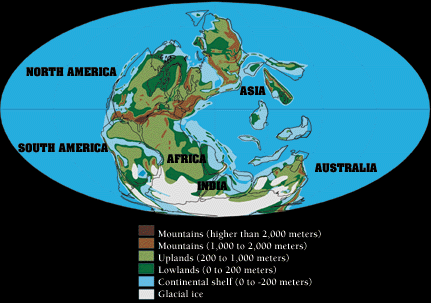 The University of Chicago Magazine December 1995
The University of Chicago Magazine December 1995
Distant Planet? While it may not look like home, it is in fact Earth, 281 million years ago. Straddling the equator is the C-shaped supercontinent Pangea, formed when the globe's major landmasses collided. The continents (today's coastlines are outlined in black) began drifting apart around 150 million years ago, as the dinosaurs were just getting started, but they still bear scars from their clubbier days: The Ouachita, Appalachian, and Atlas mountains, for instance, are among the remnants of a collision belt that ranged from Mexico, through the eastern U. S. and north Africa, into western Europe. This map is part of a 1995 series on the Permian period and summarizes the Paleogeographic Atlas Project's best estimates of continental positions, topography, and seaways that overlay continental plates.
RETURN TO OPENING OF "MAPPING A PLANET'S RESTLESS PAST"